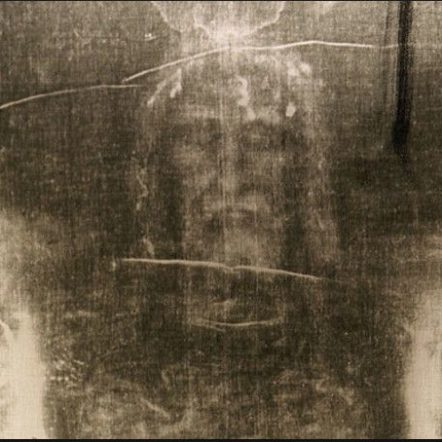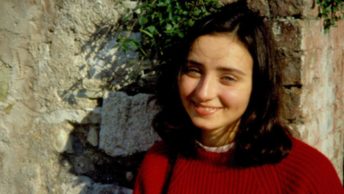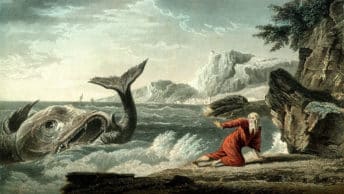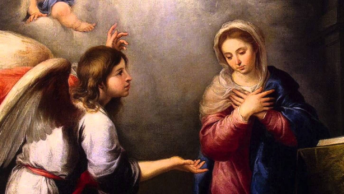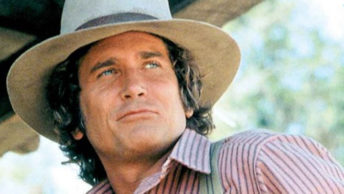I would like to call your attention to a line in John’s Gospel. The Gospel says that, “John arrived at the tomb first. (20:4) He bent down and saw the burial cloths there, but did not go in. When Simon Peter arrived after him, he went into the tomb and saw the burial cloths laying there, and the cloth that had covered His head, not with the burial cloths but rolled up in a separate place.” The Gospel goes on to say, and this is the line I want to call your attention to, “Then John went in, and he saw and believed.” (20:8)
If it is our understanding that every word of scripture is inspired by God, it follows that every word and detail must also be important. Recognizing, therefore, the importance of every word and detail, why is there the mention of the burial cloth and the separate cloth that had covered the head? Why is God calling our attention to these items? And if these items were important enough to cause John to see and believe, wouldn’t it be logical to assume that these items would have been kept by Peter and John? I would have a hard time believing that after seeing and believing, they would have just left them behind?
Now, I believe that most of us have undoubtedly heard of the Shroud of Turin. Turin is a city in Northern Italy. In a Cathedral in Turin is a piece of cloth, or a shroud, that measures 3.7 ft. wide by 14.3 ft. long. This cloth has an image imprinted on it that shows the front and back of a crucified man. In fact, the History Channel has recently broadcast a two-hour program that featured the Shroud of Turin. In that program they explored the three dimensional characteristics of the image on the Shroud. Although the shroud is the subject of much controversy, many believe this shroud to be the burial cloth mentioned in John’s gospel.
In 1978, a group of scientists conducted some exhaustive tests on this shroud and could find no evidence of forgery. In other words, the image on the shroud was not created by any known man-made method. These tests revealed many interesting facts and details about the shroud, but there was one discovery that I found particularly interesting. These tests revealed traces of a rare form of calcite dust; a calcite that can only be found in Jerusalem, typical of what might be found in a rock hewn tomb there. In 1988, these scientists were permitted to do some radiocarbon dating tests on a small sample of the shroud, but contaminants on the sample piece that was used raised serious controversy over the reliability of the test results. And as such, the date of origin could not be confirmed. Historically, this shroud can be traced accurately back to the year 1204. There is no clear historical record prior to that date. When you look at the shroud, you can’t help but see areas that have been repaired. These areas were damaged in a fire in 1532.
But what about the other piece of cloth, the one that covered Jesus’ head, the one that was rolled up in a separate place? What happened to it? In a city called Oviedo in Northern Spain is a Cathedral and in a chapel attached to the Cathedral is a small, bloodstained, dishcloth size piece of linen, measuring only 33” by 21”. This piece of cloth was quickly mentioned in that program aired on the History Channel. Many believe that this is the cloth mentioned in today’s Gospel, the cloth that covered Jesus’ head.
In ancient Rome a piece of cloth, called a Sudarium, was used to wipe ones face of grime and sweat. The word “Sudarium” is Latin word for “face cloth” or “sweat cloth”. Tradition has it that this cloth, kept in the Cathedral, commonly known as the Sudarium of Oviedo, was used to cover Jesus’ bloodied face following His death on the cross. Unlike the Shroud of Turin, the history of the Sudarium is clearly documented. It’s history can be accurately traced all the way back to the year 570. And there are additional documents that trace its path back to first century Palestine. But unlike the Shroud of Turin, there is no image on the Sudarium, just stains from blood and bodily fluids. Furthermore, the Shroud of Turin and the Sudarium of Oviedo are made of the same identical material; but the weaves are different. The Shroud is a fine herringbone weave whereas the Sudarium is a rough weave, like that of muslin.
A key date in the history of the Sudarium is March 14 in the year 1075, when the wooden chest containing the Sudarium was officially opened by King Alphonso 6th. The team that opened the chest consisted of the King, his sister, and a number of bishops. They prepared themselves by fasting and praying for 40 days. When the chest was opened, they carefully recorded their findings. And those documents indicate that they found four items; the Sudarium, the sole of Peter’s sandal, a piece of cloth from Mary’s garment, and a document attesting to the genuineness of the contents. These items have been kept in the Cathedral of Oviedo ever since.
To you and me, the Sudarium would appear as nothing more than a badly stained piece of cloth. But forensic tests conducted on the Sudarium, and their report that was filed in 1999, revealed some interesting information. For example, this team of forensic experts and scientists were able to identify such things as facial geometry, cheek bones, eye brows and beard. This report that was filed by that team states that, “Forensic analysis of the above mentioned Sudarium suggests strongly that both the Sudarium and the Shroud of Turin covered the same human head at nearly the same time.” They state that the blood stains on the cloth indicate that the cloth was placed on the dead man’s head while the body was still in the vertical position. The blood stains on the Sudarium are ‘AB positive,’ the same type as those found on the Shroud of Turin.
Additional stains on the Sudarium consist of one part blood and six parts fluid, deposited on the cloth when the body was placed in a horizontal position. It should be noted that the final cause of death for a crucified person is asphyxiation. Fluid collects in the lungs, and when the body is laid horizontally, this fluid can come out through the nostrils and mouth. Pollen grains found on the Sudarium are identical to those found on the Shroud. Pollen from plants found only in Jerusalem. There are marks or stains on the Sudarium that were obviously made by fingers holding the cloth close to the nose and mouth when the body was in the horizontal position.
There are smaller blood stains on the Sudarium that were made when the cloth came in contact with the back of the man’s head from wounds made by small sharp objects, logically from the crown of thorns. And when the Sudarium is places on top of the Shroud of Turin, the blood stains, the thorn marks, and the facial features line up perfectly. The report ended by stating that, “The only possible conclusion is that the Oviedo Sudarium covered the same face as the Shroud of Turin. The Sudarium was obviously placed on the head after death and it was removed prior to the head being covered by the Shroud.”
As far as I know, there is no official Church statement attesting to the authenticity of these two items. But I find the matter fascinating. You can almost visualize in your mind the sequence of events. Jesus suffered and died an excruciatingly painful death on the cross. After He died, someone covered His head with a cloth out of respect for Him and to save his mother more anguish. As they took His body down, someone held the cloth in place on His head. They kept the cloth on His head as they took the short journey to the tomb. When they arrived at the tomb, they laid down a long linen shroud and placed His body on top of it. They then removed the cloth that was covering His head and then wrapped the long linen shroud over the body. They then laid the small cloth off to the side and quickly left, with the intention of returning after the Sabbath to complete the requirements of their burial ritual. However, early in the morning on the third day, before they returned, Jesus rose from the dead. Within the wrappings of the shroud there was a tremendous burst of pure energy and light. The linen wrappings collapse like a deflated balloon, leaving an indelible image of His body on the inside of the shroud. No image was left on the smaller piece of cloth because it was lying off to the side.
When you think of it that way, you can understand why John saw and believed. We traditionally associate Easter with happiness and Joy. To us, Easter is Lilies and sunshine, happy children and Church choirs. It is new spring wardrobes and Easter baskets, Easter bunnies, and colored eggs. For Christians around the world, this is the most popular Sunday of the entire year. The first Easter, however, did not happen in a Church or Cathedral. It happened in a cemetery. It did not occur on a stage for all to see, but in a darkened tomb. Resurrection was God’s response to the worst that the world could do.
Easter may be a joyous time for us, but remember, the prerequisite for resurrection is death. It is perfectly understandable that we would want the good news without the bad news. To talk of death is depressing. Jesus’ death, even though it took place almost 2,000 years ago, is a grim and painful subject to think about. The story of Holy Week is dark and tragic. Life is hard enough without reliving Jesus’ crucifixion. But resurrection has no meaning apart from death. Resurrection only occurs when someone has died.
It is impossible for us to appreciate the reality and finality of Jesus’ death for His followers. Having heard the story so often, we cannot feel the impact of His death as they did. His followers believed they had lost Him forever. For them, it was the end of everything that mattered. When you read the Scriptures, it is very obvious that no one among all His followers expected the resurrection.
What was the point of the resurrection for Jesus’ followers? Well, think of it this way. John tells us that Mary Magdalene went to the tomb as early as she could- “while it was still dark”. She did not go expecting to find Jesus alive. She knew that death was real. She went to mourn the loss of her dearest friend. The risen Christ was a shocking surprise to Mary, the last thing she might have expected. The point of the resurrection, for Mary, for his followers then, and for us today, is that, by the surprising grace and power of God, Christ has conquered death. He has set us free from the bondage of death. Death no longer has the last word. Death no longer has dominion over us, nor does the fear of death.
An ancient symbol of resurrection and new life is the butterfly. Few things in nature appear less promising than a cocoon. The cocoon just looks like a little wad of dead matter. If you didn’t know any better, you would never expect the cocoon to contain or produce such life and beauty. The cocoon gives no evidence of the incredible loveliness and beauty that will come forth from it.
Life sometimes looks like a wad of dead matter. Sometimes we arrive at, what appears to be, a dead end. We sometimes find ourselves in situations that seem like we’re in a tomb. All appears dark and cold. It is important to remember, in times like that, that God has a plan for our lives. And it is in those dark times that God is at work transforming death into life, darkness into light, despair into promise. It is in those times and places, where you least expect it, that you find God opening a new future filled with surprising and unexpected promises.
Easter is not merely the commemoration of an ancient miracle, a two-thousand year old resurrection. This relegates it to the past where we cannot go. Neither is Easter merely the promise of life after death. This pushes it into the future. Whatever it means for either the past or the future, resurrection happens in the midst of life. Whatever the future holds, wherever life’s journey takes us, we must remember, we must hold fast to, and we must trust in our God of the Resurrection, in our God of eternal life.
John saw and believed. May we too have the eyes of faith that enable us to see the wonders of God and believe in His eternal love and promise for us.

